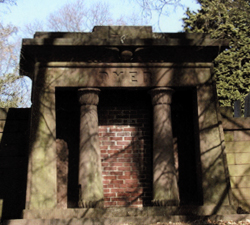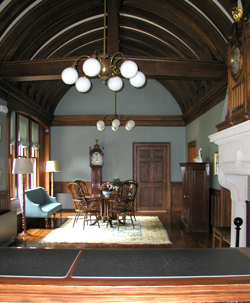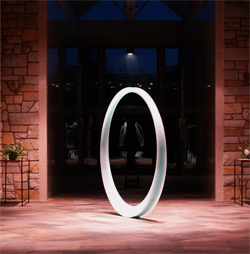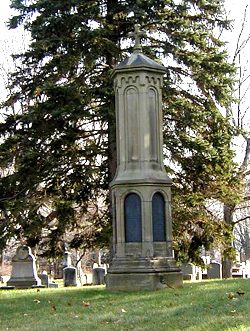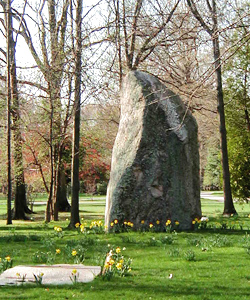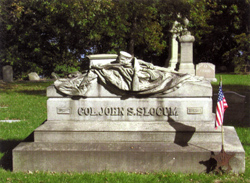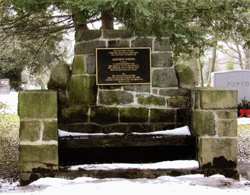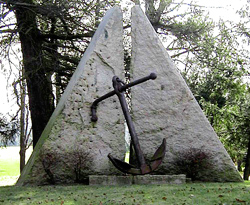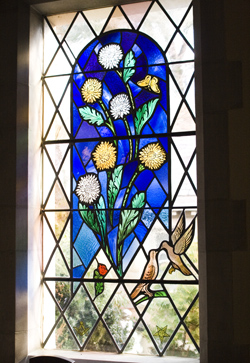The size and elaborateness of monuments may give us a clue about the deceased – their religious beliefs, their culture, their professions, their station in life.
As burial customs, religious beliefs and attitudes about death changed, so did cemetery trends. When industrial cutting tools became available, simple markers were replaced by more elaborate monuments.
The late nineteenth century markers at Swan Point reflect the opulent taste of many wealthy families buried in the cemetery at this time. Generally larger and more lavish than early and mid-nineteenth century markers, these monuments, obelisks, ledger stones, and sarcophagi are often made of granite or marble though other stones were occasionally used. The elaborateness of these markers reached its fullest development with the inclusion of life-size statuary – portraits, angels, and occasionally, gisants and more explicit death iconography, for example, broken or unraised columns and broken pitchers which symbolized early death. Detailing became more elaborate and many markers from this period were decorated with deep carving, heavy rustication or swag ornamentation.
By the turn of the twentieth century, a general preference for smaller, simpler monuments returned. Most of the twentieth century monuments at Swan Point are made of granite, which serve to mark the graves and smaller lots rather than to commemorate individuals or families.
The Dyer Family Crypt
A brownstone Egyptian Revival tomb, designed by Russell Warren in the late 1830s, it is built into the eastern slope of a hill overlooking the Seekonk River. Its façade features a central entrance flanked by sturdy columns with acanthus capitals.
The Sprague Family Monument
A substantial granite monument designed in the late 1860s by noted Providence architect, James Bucklin, this monument was modeled after the fourth-century B.C.E. Choragic Monument of Lysicrates in Athens, Greece. The sarcophagus of two of the Sprague children is adorned with a marble giant sculpture carved by Charles Hemenway in the late 1860s.
The Lockwood Sarcophagi
Two similar sarcophagi with elaborate, deeply carved swag ornamentation are found in the Lockwood lot.
The Grosvenor Lot
The Grosvenor Lot contains a tall but broken Ionic column, symbolizing early death, covered with carved vines. Adjacent to the Grosvenor lot is the Joseph Brown Pyramid, which, like so many nineteenth century monuments makes reference to historic burial practices.
Italian Marble Fountain
Imported from Italy by Marsden J. Perry, the Marble Fountain was originally set up on the grounds of the John Brown House where Perry lived from 1902-1935. The Rhode Island Historical Society acquired the fountain in 1941 and subsequently gifted the fountain to Swan Point in 1961.
The Original Receiving Tomb
Designed by Thomas Tefft in the round-arch, Lombard Romanesque style that Tefft favored.
John Rogers Vinton Monument
A brownstone sarcophagus, it features the cannonball that felled him in the Mexican American War atop the monument. Bollards shaped like cannon barrels surround the sarcophagus.
The Lownes Monument
The Lownes Monument features a bronze sculpture by Isidore Konti (1862-1938) a Viennese-born artist who studied at the Vienna Imperial Academy.
The Boy and Girl Fountain
A statue of a boy and a girl standing under an umbrella in a fountain was set up in the 1870’s near Forest Avenue. A fixture at Swan Point for 85 years, the original fountain was stolen in 1968 but replaced in 1974. It now stands in the Historic Chapel courtyard.
Little Sarah
A lovely marble statue of a little girl which had graced the Wilkinson family lot for over 100 years, was stolen from her pedestal in 1978. In 1980, an Italian sculptor was commissioned to recreate the statue from a photograph of the original. In 1981, “Little Sarah” was safely relocated in the Historic Chapel courtyard and a ledger stone was placed on the original site to explain what had occurred.
Administration Building and Historic Chapel
One of the cemetery’s most renowned architectural features, it is a one-story Gothic Revival structure faced with Weymouth seamface granite and Indiana limestone. Situated near the entrance to the cemetery, the main building was designed and built by the distinguished architectural firm, Stone, Carpenter and Willson in 1905. A chapel, designed by John Hutchins Cady, was added to the north of the building in 1932. This was followed by an enlarged chapel in 1947.
Redwood Mausoleum, Chapel and Columbarium
The Redwood Mausoleum, Chapel and Columbarium complex is located at the southern end of the cemetery. It was designed in a variation of English Country Gothic and Arts and Crafts Movement to blend with the earlier cemetery buildings.
The Redwood Chapel, designed in a manner similar to that of the Historic Chapel located in the administration building, seats approximately 100 people. Large arched, oak ceiling beams, an intricate pattern of limestone floor tiles, and handcrafted furnishings provide a warm Arts and Crafts environment.
Colure Sculpture
Seven feet in diameter, Colure is a circular, jade-like glass sculpture designed and created by contemporary glass artist, Daniel Clayman. Clayman chose the circle design because it is a universal symbol of hope, moving forward, and life continuity – constant themes in his work. Colure is on permanent display in the Redwood complex where it provides a perfect focal point for reflection and contemplation.
Pastor’s Rest Monument
Designed by Thomas A. Tefft and made of Nova Scotia stone by the Tingley Brothers, it was erected in 1850 to designate the Burial Ground of the First Congregational Society in Swan Point Cemetery, to which the bodies had been removed in 1848. The monument stands in an enclosure near the center of the Burial Grounds, called Pastor’s Rest, a section dedicated to the memory of the deceased Pastors of the Society whose names and terms of office are inscribed on the monument.
The Megalith
In 1978, Swan Point set the Megalith, what is believed to be the largest single stone erected in an American cemetery, in the midst of Memorial Grove. Weighing over 50 tons, the boulder was found in Westerly, RI, and according to its geology, the stone has been part of the structure of what is now RI, for at least five million years. The megalith is a central feature in a park-like grove of trees at Swan Point called Memorial Grove.
Paul Krot Monument
A minimalist circular granite form erected in 1992 to mark the grave of Paul Krot, a professor of photography at Rhode School of Design.
Colonel John Stanton Slocum Monument
A finely carved, highly personal, granite sarcophagus embellished with the names of battles in which he participated in the Mexican American War and the Civil War. It is capped with military accoutrements including a sword, epaulets, a cap and cape.
Alfred Stone Memorial
A stone seat, designed by Norman M. Isham, erected in 1910, as a tribute to Stone, in appreciation for his ability as an architect, his service as a citizen and his character as a man, by his associates in the Rhode Island Chapter of the American Institute of Architects.
The Hope Memorial
A mixed-medium sculpture made by two triangular granite monoliths as a backdrop for an eighteenth century anchor recovered from Narragansett Bay. The anchor is a symbol of hope and the State of Rhode Island, whose flag and seal it graces. Designed by Brown University art professor Richard Fishman, the stone sculpture was originally installed at an outdoor chapel on Providence’s Killingly Street in 1972 and was moved to Swan Point in 1976.
Nightingale Monument
Erected in the memory of realtor Samuel Nightingale’s (1828-1906) only child, Nina and his wife, also named Nina, this monument is a larger than life size bronze sculpture of an angel rising heavenward, bearing an infant in her arms. It is set on an oval-plan plinth cast by A. Rolland.
Stained Glass Windows
Beautifully crafted stained glass windows depicting nature scenes adorn both the Historic Chapel and the Redwood Chapel. All of the chapel windows may be inscribed and offered as memorials. Many windows are already memorialized and more are available.

